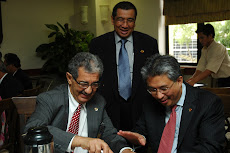Datuk Naim Mohamad speaking at the UMNO General Assembly
(An Archive Photograph)
There is need for a thorough evidence-based review of Malaysia’s affirmative action policies that began with noble objectives 40 years ago.
THAT the New Economic Policy has succeeded in eradicating poverty and eliminating the identification of race with economic function is not disputed. Malaysia’s poverty rate has plummeted from over 50% in the 1970s to only 1.7%, according to the 2012 Household Income Survey.
Bumiputras employed in the professional and management category have outstripped Chinese and Indians, while those qualified as doctors, engineers, and architects are almost proportional to the country’s racial composition.
Similarly, bumiputra corporate equity has gone up from only 2.4% in the 1970s to 23.5% in 2011, and according to other measurements, even higher.
These are all laudable achievements. No one is questioning the twin objectives of the New Economic Policy.
However, the debate today remains how best to achieve these objectives in the context of a more globally competitive environment, persistent income inequality over the past 10 years, growing intra-ethnic income inequality and other divides such as rural/urban, and peninsula Malaysia/Sabah-Sarawak.
Given these inequities and the rising intra-ethnic income inequality among the bumiputras and between Malay and non-Malay bumiputras, most of whom live in Sabah and Sarawak, isn’t it time for the Federal government to start addressing the needs of poor bumiputras through a differentiated approach?
Can an affirmative action policy targeted at bumpitras continue to treat this ethnic group as one homogenous community when data show increased intra-ethnic inequality as one outcome?
Should a policy designed to build national unity from the ashes of May 13, 1969, continue on the basis of ethnicity when this has resulted in increased communal tensions and undermine social cohesion?
What should be done?
Many Malaysians believe the unexpected announcement of the Bumiputra Economic Empowerment (BEE) programme was more of the same and politically motivated to appease Umno’s own Tea Party hardliners in the run-up to party elections.
It is short-term in approach and does not address weaknesses in policy-making and implementation, which has seen billions allocated to bumiputra economic empowerment and dozens of policy instruments and schemes over the decades still failing to build the resilient bumiputra commercial and industrial community and address the needs of those left behind.
What is really needed today is not more handouts to bumiputra but a serious policy review of affirmative action policies of the past 40 years, where they have worked and where they have failed, and what best long-term steps should be taken to address the various inequities in this country.
This review should be based on empirical evidence and data, not on emotions, threats and accusations.
Should the NEP continue to be race-based or needs-based to end poverty, regardless of ethnicity?
A persuasive argument can be made that even if affirmative action is based on need, the bumiputras being the majority population of this country will still be the group that will benefit the most. As reported in the New Economic Model for Malaysia, of the bottom 40% of households that earn less than RM2,000 a month, 77.2% are bumiputras.
In effect, 80% of Malaysian households earn less than RM5,000 per month.
It is no wonder that, according to the Internal Revenue Board, only one million of the 12.7 million Malaysians in the work force are eligible to pay tax, making wages and salaries contribution to Malaysia’s GDP very low.
The EPF reported that 78.6% of its contributors earn less than RM3,000 monthly. The low salary can be explained by the fact that some 77% of Malaysian workers have only SPM qualifications.
These are all troubling data in a country that aims to attain developed country status, with per capita income of RM48,000 by 2020.
Even if this is achievable, without addressing the gaping income inequality, this high income country status will remain an illusion for the individuals making up 80% of Malaysian households earning less than RM5,000 a month.
Obviously, the details of the BEE still need to be worked out. A major concern is that the policy announcement made no mention of targeting the bottom 40%, to reduce the inequity gaps between the rich and poor, the urban and rural, the bumiputras in the peninsula and those in Sabah and Sarawak, where poverty rates are higher.
There is also worry that a resort to quotas yet again will further reduce bumiputra competitiveness and resilience in an increasingly interconnected, globally competitive world economy.
Much has been written and debated on the effectiveness of affirmative action policies to redress historical injustices. A new book on the New Economic Policy, The New Economic Policy in Malaysia: Affirmative Action, Horizontal Inequalities and Social Justice (National University of Singapore Press, 2013), edited by Edmund Terrence Gomez and Johan Saravanamuttu, suggests four lessons to be learnt.
> First, the duration of affirmative action. Any such policy based on horizontal inequalities (inequalities based on culturally defined groups, rather than individuals or households) must have a time limit. Research shows that the most successful period of the NEP was its social restructuring phase in the first 15 years.
Significant progress was made to eradicate poverty, increase bumiputra ownership of share capital, increase bumiputras in the professional and management category of occupations, and reduce income disparity between bumiputras and non-bumiputras. The focus on education for bumiputras paid high dividends in creating a bumiputra professional and middle-class group.
The question being asked today is whether the results of continuing affirmative action policies and instruments are worth the billions of resources poured in, and worth the impact on economic growth, efficiency and competitiveness, and bumiputra independence and resilience.
> Second is inequality of access. This has led to growing intra bumiputra income inequality. Who are those who have benefited most from IPOs allocated to bumiputras?
Even then, the government has admitted of the RM54bil worth of stocks allocated to bumiputras since 1971, only RM2bil remains in bumiputra hands.
A clear spatial divide (disparities between beneficiaries in different regions) has appeared where poverty is most severe in the Malay heartland of Kelantan, Terengganu, Kedah and Perlis and among the orang asli and non-Malay bumiputras, with Sabah being the country’s poorest state with a poverty rate of close to 20%.
> Third, affirmative action should focus on providing high quality primary and secondary education to better prepare bumiputras to take advantage of the tertiary educational opportunities offered to them.
The high unemployment rate among bumiputra graduates, and the high percentage of local bumiputra graduates being absorbed into Government and statutory bodies show a lack of capacity to acquire a sound education that can lead to more competitive advantage in the labour market.
A study on the impact of exclusive bumiputra admissions quotas and academic performance was revealing.
Of the 271 first semester students studying linear algebra in an engineering faculty, only 13.6% of those who scored an A in matriculation mathematics scored an A in the university course, while 61.6% of those who scored an A in STPM mathematics scored an A in university algebra.
Evidently, the STPM of the national school system prepared the students better for university than the specially set-up matriculation system to improve bumiputra performance in maths and science.
> Fourth, preferential treatment in business to produce a bumiputra commercial and industrial community has failed to propel the growth of a large robust pool of independent bumiputra businesses.
According to a study, in spite of intensive privatisation and a policy of “picking winners”, no bumiputra-owned firm appears in the Top 10 lists of companies either by revenue, profit or return on revenues.
State support for development of Malay capital has fostered the expansion of a bumiputra rentier class and a corrupting intertwining of business and politics that undermine economic confidence, growth and competition.
Before more handouts are given out in the name of a presumed homogenous bumiputra community, there is need for a thorough evidence-based review of Malaysia’s affirmative action policies that began with noble objectives 40 years ago, now mired in cynicism that the policy has largely benefited and enriched an elite class of hand-picked cronies the most.
Already, questions are being asked on who will benefit most from the RM10bil being pumped into ASB2, when some 75% of unit holders of ASB actually own only an average of RM611 per person.
By Zainah Anwar in the STAR's Sharing the Nation column.
By Zainah Anwar in the STAR's Sharing the Nation column.


































No comments:
Post a Comment